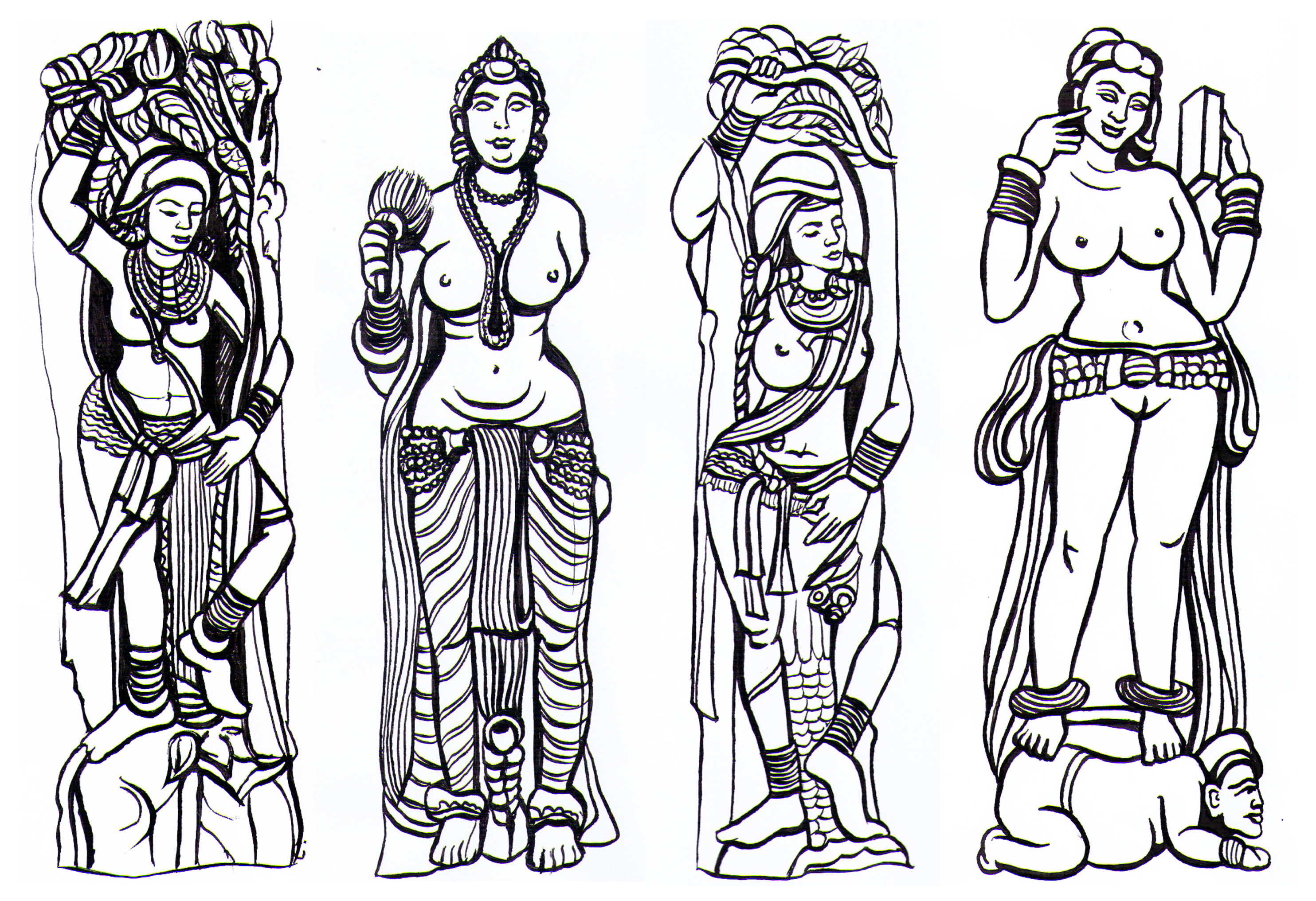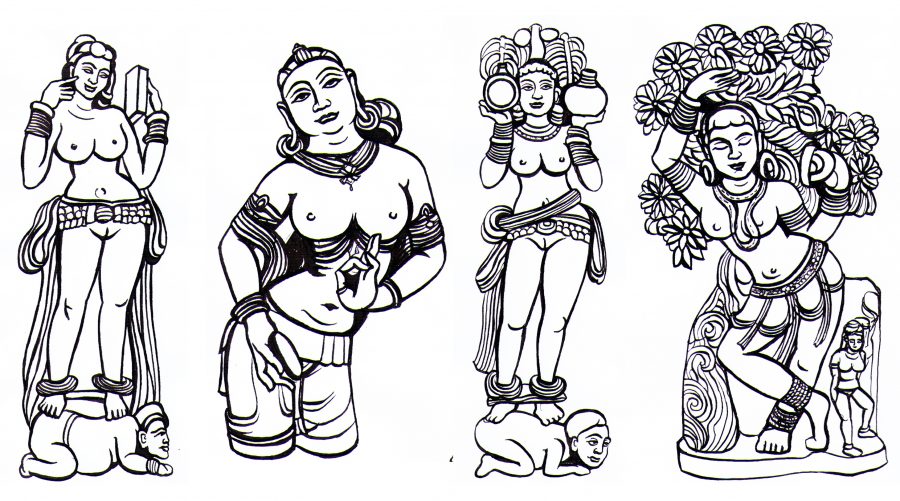The different faces of the yakshini. Drawing by the author
Yakshini are mythical creatures in the Hindu, Jain, and Buddhist traditions, effectively representing the female counterparts of the male magical nature spirits, yaksha. The Sanskrit term yakshini is customarily translated as demoness. They are a class of demigoddesses, primarily tied to natural phenomena of growth and life, especially mountains, plants, and trees. They are often seen as spirits of trees and personify the creative energy and feminine power in its various aspects.
Yakshini have a number of different manifestations and capable of demonstrating supernatural powers. They can take the form of noble and virtuous human beings who help secure a rich harvest and wealth, or ethereal spirits, nymphs, and fairies. They can also be cruel and ill-tempered, and yearn for human flesh and blood. Within the Buddhist tradition their fierce and merciless nature is commonly exaggerated, so that disciples would focus their attention on various ethical values such as non-violence and compassion.
Another aspect of the yakshini is their role as seductresses of mortal men. As supernatural creatures they can take on any physical shape, most commonly those of attractive women. Some legends tell of yakshini who get married and give birth to children. The Padakusalamanava Jataka mentions the Buddha as being the product of such a marriage in one of his past lives.
According to the Buddhist teachings even the most unruly yakshini can change their temper and accumulate wisdom and spiritual merit, which will bring them closer to the cherished goal of all Buddhists: attaining enlightenment. They can not only become adherents of the Buddhist doctrine, but also come to be its valuable protectors. If they are propitiated with suitable mantras and offerings, they can take shape as mothers, sisters or lovers of Buddhist practitioners, provide them with great wealth, and fulfil their worldly wishes.

According to Buddhist legends, yakshini live on the mythical mountain of Meru. They also inhabit other sites such as mountains, sources of water like lakes or rivers, caves, city gates, trees, groves, and cremation grounds. Their leader is considered to be the bodhisattva of wisdom Manjushri. Yakshini and yaksha accompany the god of wealth, Kubera, who governs the mythical Himalayan kingdom Alaka. Within the Buddhist tradition Kubera as the king of yakshini (yaksharaja) is believed to be master of riches, protector of the world (lokapala), and protector of Dharma (dharmapala).
Yakshini originate from ritual practices which were already present in India before the time of Buddha Shakyamuni. They were integrated into the early Buddhist tradition and assumed a significant ritual role. Notwithstanding the emergence and evolution of the Buddhist doctrine, people continued to worship the creative power of nature and preserved their belief in yakshini as nature’s personification. Consequently, these local demigods found a noteworthy home in Buddhism. Some scholars even claim that allowing their continued worship was a key factor in the expansion of Buddhism.
These captivating creatures have provoked conflicting opinions in relation to the Buddhist concept of detachment and renunciation of sensual pleasures. There is a number of responses to the question whether such provocative female figures deserve a place amongst Buddhist reverence.
Some think that they are too erotic to decorate Buddhist monuments with. They are seen as indecent and voluptuous only to provoke sensuality and desire without religious meaning. Others believe that they express the worldly attractions that need to be renounced in order to attain liberation. The conflicting opinions that yakshini arouse mean that they attest to the wide spectrum of views that the Buddhist faith accommodates. On the one hand, Buddhism proclaims an aspiration for freedom from the desire that causes all suffering as well as detachment from exterior phenomena, but on the other hand, it places on a pedestal the worship of nature in all its beauty, fertility, sensuality, and vitality.
According to the Buddhist tradition, yakshini are an embodiment of nature in all its creative and destructive aspects. They are also a symbol of the universal hope for a happier and more harmonious life.


Hello, I am curious about information regarding Yakshinis in human form. Regular people with this Yakshini spirit . You mention above “They can take the form of noble and virtuous human beings who help secure a rich harvest and wealth”. Do these people have a particular role and responsibiltiy ? Does the tradition speak on who these human yakshini’s are and what they should be doing ?
I think there are some sources that take for granted that these yaksha or yakshini, having taken on such good forms, are there for benevolent purposes or to help people. Those that take less benign forms are, ipso facto, more malicious kinds of spirit. Exactly who the good yaksha/yakshini are is not always clear…